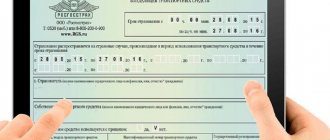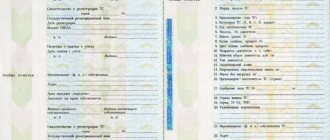What do the traffic police look at when registering a car?
It is impossible to register a car without undergoing an inspection by traffic police officers. Before submitting the package of documents, the car owner must present the registered vehicle to the viewing platform, which, as a rule, is located next to the traffic police department.
The car owner must:
- drive up to the inspection site;
- turn off the engine;
- open the hood and wait for the traffic police inspector to check.
In accordance with the Administrative Regulations of the Ministry of Internal Affairs (Order of the Ministry of Internal Affairs of the Russian Federation dated August 7, 2013 No. 605), the inspector must carry out a visual inspection of the external characteristics of the vehicle , compare the numbers stamped on the vehicle with the numbers indicated in the vehicle passport, and also check their authenticity.
Inspecting the vehicle allows you to make sure that:
- the documents provided by the car owner correspond to the car inspected;
- the vehicle’s structure is not damaged and does not pose a threat to road users;
- The requirements for vehicle window tinting have not been violated.
If during the inspection the traffic police officer discovers any inconsistencies, he has the right to refuse the car owner to register his vehicle.
How to prepare a vehicle?
Attention. To avoid problems with registering your car and to ensure that the inspection procedure goes quickly, you should prepare for it in advance.
Before going to the traffic police, the car owner should:
- Wash the vehicle so that the inspector can easily perform a visual inspection.
- Remove all unnecessary items from the car in case the inspector wants to look into the trunk of the car.
- Remove tint from the windshield and front windows of the vehicle.
- Check the condition of the wheels (tire wear and disc diameter).
- Replace all car parts that do not meet the standards (headlights, steering wheel).
- Find and check the VIN code on the car body, chassis number and engine number. The numbers should be easy to read.
Motor inspection
Separately, I would like to note the inspection of the engine. At the moment, the engine is not a mandatory inspection element, and most likely they will not look at its number. But here’s what you need to understand: if your car is not equipped with a “native” engine, but, for example, a more powerful one from another manufacturer, then you will also be denied registration; there have already been similar cases.
When buying a car, pay attention to the engine; if you have any doubts about the technical condition of the car, negotiate with the seller, take it for service, or better yet, look at other options. The secondary market is now overflowing with a huge number of different cars; you definitely won’t be left without a car.
Friends, be extremely careful when buying a car. It’s better to choose, as they say, a “naked” car, let it be on stock wheels, with a factory engine, without tinting, and of course, legally clean. And then you won’t have any problems with registration.
If you liked the article, I suggest you subscribe to blog updates to stay up to date with the latest automotive topics.
Share this post
- Related Posts
- Registration of HBO in the traffic police
- Do dealers provide a replacement vehicle during warranty repairs?
- Car resellers - principles and schemes of their work
- How to scrap a car and get a discount on buying a new one
- Which is better to buy a thickness gauge for inspecting a car?
- Useful gadgets for car inspection
Features of the procedure
During the inspection, the traffic police inspector pays attention to the following details:
- verifies the data of the numbers (VIN code, chassis and body) in the documents provided by the car owner (PTS, STS) with the data stamped on the car;
- checks the level of tinting of vehicle windows;
- establishes compliance of the steering wheel in the car with the factory specifications;
- checks whether the headlights in the car comply with the factory standards of this car brand and GOST.
In addition, attention is paid to the design of the car itself. Violations in it most often lead to refusal to register a vehicle. Thus, a traffic police officer will not allow a car with a roaring engine, low seating position or other changes in design to be registered.
If gas equipment is installed in the car, the vehicle owner must provide the inspector with permits.
If they are absent, registration will be refused, and the car owner will be obliged to eliminate the existing violations (remove the equipment or obtain documents for it for further registration of the car).
Do I need to pay for it?
The mandatory inspection that every car must undergo before registering with the traffic police is free of charge. The car owner pays only the state fee for carrying out registration actions and issuing state registration plates (if necessary).
How long does it take?
Important. The car is checked on the day of application. Administrative regulations set the time for inspection - 20 minutes.
As a rule, the procedure itself is faster, but the waiting time can significantly exceed 20 minutes, since cars arrive at the site on a first-come, first-served basis.
In what form is the report drawn up after checking the vehicle?
After completing the inspection procedure, a vehicle inspection report is drawn up. It is mandatory for further registration of the car. The document contains the following information:
- Title of the document;
- date and place of inspection;
- the basis for the procedure;
- vehicle data (make, model, etc.);
- vehicle condition and detected violations;
- Full name and signatures of the persons conducting the event.
The car owner provides the report received from the inspector and other necessary documents to register the car.
Validity
According to the Administrative Regulations (Order No. 605), the validity period of the inspection results is 30 days from the date of its conduct.
When is a more in-depth examination scheduled?
If, after checking the car, the traffic police inspector does not have any questions, then the vehicle is allowed for registration, and if any discrepancies are identified, the car may be sent for additional examination. It is usually prescribed in the following cases:
- the design of the vehicle is damaged, which makes its operation unsafe;
- the numbers on the body are impossible to read;
- the inspector had doubts about the authenticity of the numbers;
- the characteristics of the car do not match those indicated in the title;
- The vehicle or its documents are being sought.
A traffic police officer on the spot cannot conduct a more detailed technical check, so if there is any suspicion, the car is sent for examination.
Attention. An examination is not just a visual inspection of a vehicle, but a set of measures that allow you to assess whether the car is legal.
Where is it held?
Any institution that has passed the appropriate certification has the right to conduct an auto inspection . The expert who will conduct the vehicle inspection is allowed to participate in the procedure only if he has permission to issue an expert opinion.
The examination can be organized:
- full-time criminologists of the Ministry of Internal Affairs;
- independent experts.
The choice of organization depends on the goals set: if there are suspicions that the car was involved in a crime, then the check is carried out by employees of the forensic departments of the Ministry of Internal Affairs.
What can be revealed during this audit?
During the examination, the car undergoes a thorough check. In general, experts check almost the same characteristics of a car as a traffic police officer during an inspection, but they use special devices and technical devices.
The examination includes:
- checking the technical condition of the car;
- assessment of the authenticity of license plates on the body and their compliance with the data in the vehicle documents;
- checking vehicle documents in the databases of various institutions in order to find out the true information about the vehicle.
After the examination, the specialist must exclude any illegal changes to the vehicle or, conversely, establish the fact of their existence.
If an expert, for example, confirms the falsification of the license plate on the body of the car, then a criminal case will be initiated against the owner of the car under Part 1 of Art. 326 of the Criminal Code of the Russian Federation.
Price
The cost of the procedure depends on the level of its complexity and may differ in each specific case. If a car owner turns to an independent company, then he independently pays for the services of experts.
Rates may be as follows:
- checking the VIN code for authenticity – 2000-3000 rubles;
- establishing a complete vehicle history – 2000 rubles;
- authenticity of documents – 1500 rubles;
- determination of actual mileage and service history – 3,000 rubles.
The deeper the research is required, the more expensive the examination will cost.
Deadlines
A specific deadline for the examination has not been established. The time required to complete the procedure will depend on the amount of work. The work of experts can last 1-2 months. As a rule, the specialists of the traffic police forensic center are busier, so it takes them longer to complete the examination than in an independent organization.
Attention. The legislation sets aside 10 days for car owners to register their vehicle with the traffic police, but if during inspection the car was sent for examination, then it is unlikely that they will be able to meet this deadline.
To avoid paying a fine for late registration of a car, the car owner can write an application addressed to the head of the traffic police department with a request not to issue a fine. In the application, indicate the reason (passing the examination) and attach documentary evidence of this fact.
What document is issued after the examination and how long is it valid?
At the end of the examination, the car owner is issued a certificate containing the following information:
- place and date of the inspection;
- data of the expert responsible for the inspection;
- information about the identified actual data of the car;
- expert opinion.
The validity period of the act is 30 days. During this time, the car owner is obliged to register the car, otherwise he will have to go through the procedure again.
How to register the car next?
If the examination shows violations, the car may be confiscated or arrested. If, as a result of the inspection, no problems with the car were found, then the car owner has the right to register the vehicle with the traffic police.
To do this, along with the standard list of documents for registration, you will need to provide an expert opinion that there are no illegal changes to the vehicle.
You can register a car by contacting the traffic police department in the electronic queue using coupons or by making an appointment using the State Services portal.
The owner of a car who, at the request of a traffic police officer, had to undergo an examination, as a result of which no violations were confirmed, has the right to go to court with a demand to recover material and moral damage caused as a result of the examination.
The basis in this case will be a violation of the law (Articles 15, 1064, 1069 of the Civil Code of the Russian Federation).
We consider the nuances of registering trucks, scrapped, home-made and emergency vehicles, including with engine replacement or without providing the vehicle itself, in separate articles. Read about where you can register your car, how to do it on weekends and holidays, whether you can register a car for a minor, and how to check whether the car is registered.
What is the difference between inspection and inspection
inspection is a visual examination of the vehicle and the cargo being transported. That is, the inspector does not have the right to open the door and look at what is inside the car. A technical inspection is also possible, when the car is checked at a technical inspection station to allow the vehicle onto the road.
The grounds for the inspection are specified in paragraph 197 of Order of the Ministry of Internal Affairs of Russia dated August 23, 2017 N 664.
The grounds for inspection of the vehicle and cargo, that is, visual inspection of the vehicle and transported cargo, are:
— orientations, other information about their use for illegal purposes; — the need to check the markings of the vehicle and compare them with the entries in the registration documents; — presence of signs of non-compliance of the transported cargo with the data specified in the accompanying documents for the transported cargo.
Paragraph 197 of Order of the Ministry of Internal Affairs of Russia dated August 23, 2017 N 664
It turns out that the reason for the inspection may be orientation, the need to verify numbers, or the presence of signs of inconsistency with the cargo being transported. According to Article 27.1 of the Code of Administrative Offenses of the Russian Federation, which lists the measures to ensure the proceedings in the case, the inspection is not indicated there, which indicates that you can refuse the inspection at any time without reason, but then this may entail an inspection.
An inspection is an examination of the entire vehicle without violating its structural integrity.
The grounds for inspection of a vehicle, that is, an examination of a vehicle carried out without violating its structural integrity, are:
- checking data on the presence of weapons, ammunition, cartridges for weapons, explosives, explosive devices, narcotic drugs, psychotropic substances or their precursors or - poisonous or radioactive substances in a vehicle - checking data on the presence of instruments or objects of an administrative offense in a vehicle — detention of persons listed in Part 2 of Article 14 of the Federal Law “On Police” traveling in vehicles
Clause 202 of Order of the Ministry of Internal Affairs of Russia dated August 23, 2017 N 664
For the inspection, there must be an assumption that you have weapons or drugs in your car, items with which an administrative offense was committed, as well as in the event of the driver being detained. Any assumptions in this case must be justified.
The inspection is carried out exclusively in the presence of the driver or persons accompanying the goods.
Inspection of the vehicle and the cargo being transported is carried out with the participation of the driver or citizens accompanying the cargo.
Clause 198 of Order of the Ministry of Internal Affairs of Russia dated August 23, 2017 N 664
Legal consultation
Get qualified help right now! Our lawyers will advise you on any issues out of turn!
To get a consultation
As for the search, it can be carried out either in the presence of the driver or without him, but it is necessary to have two witnesses or video recording.
203. The inspection of a vehicle is carried out in the presence of two witnesses or using video recording. 204. The inspection of a vehicle is carried out in the presence of the person in whose possession it is. In urgent cases, an inspection of a vehicle may be carried out in the absence of the specified person
Clauses 203 and 204 of Order of the Ministry of Internal Affairs of Russia dated August 23, 2017 N 664











